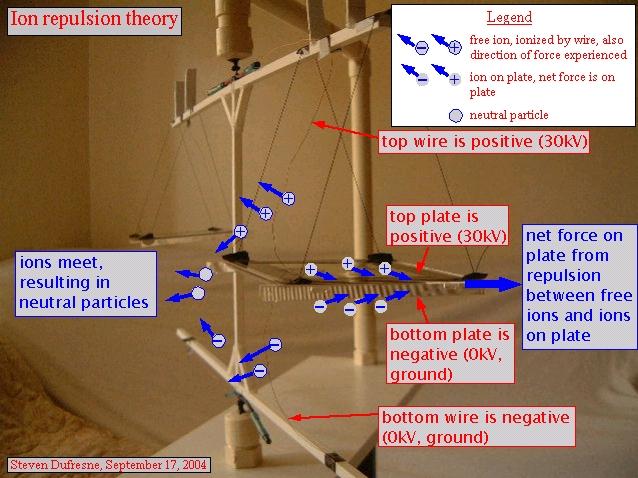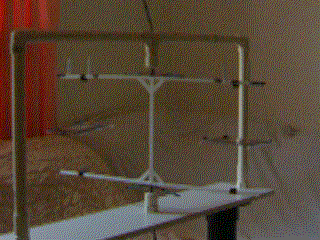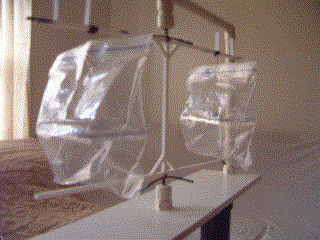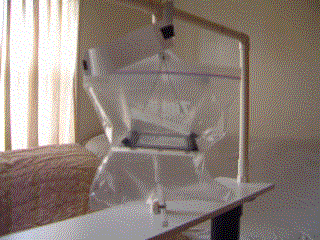Hoping that the theorized force for the Poynting Flow Thruster described by Jean-Louis Naudin was real I set out to repeat the experiments. I had first done tests in May 2001 but the results were inconclusive due to issues with my old rotor. These new tests were waiting for me to build my new rotor.
Unfortunately the source of the movement turned out to be just another form of wind. The following diagram illustrates my theory as to what is going on and the details that follow it show how my experiments support the theory. Note that I am not a theorist so while the experimental results prove the force is from some form of wind, the theory may need work (feel free to email me with refinements).
Each thruster was made from the top part of a CD case. The plates are thin aluminum foil squares (9mmx9mm) with rounded edges. The edges of the plates were covered with strips of black electrical tape for insulation. The bare copper wire used was 0.009" in diameter. The insulated wire used was multimeter wire.
|
Experiments (Sept. 14-17, 2004)
The following is the power supply and measuring instruments setup used for the experiments.
|
|
Note that in these experiments I was able to push the 30kV power supply as high as 39kV.
Experiment 1 - Bare wires connected to back of thruster plates
I electrically connected to the thrusters using bare copper wires. They were taped with aluminum tape to near the rear of each plate.
Things were very quiet except for slight clicking/hissing at the power supply.
At 24kV and approximately 25uA it started moving in the direction predicted by the Poynting flow thruster theory (in the direction opposite from the side that the wires were attached) as the animated GIF and QuickTime movies below demonstrate. At 30kV and 50uA it was moving quickly at around 20 RPM.
|
|
|
For a QuickTime movie of the above click here (2Meg). If you don't have QuickTime you can download it here. Note that if you hear a repeating clicking sound in the recording this is an artifact introduced by the camera due to its proximity to the HV thrusters.
Experiment 2 - Insulated wires connected to back of thruster plates
I replaced the bare copper wires with insulated wire (multimeter wire). They were connected using aluminum tape to near the rear of each plate.
Note that I did have some leakage as the current at 30kV was 40uA. This 40uA is close to the current pulled using bare wires above. A quiet hissing was heard from the area of the thrusters and was likely from ionization occuring where the aluminum tape imperfectly covered all of the multimeter wire touching the plate (difficult to do due to the thickness of the wire).
At 30kV and 40uA there was no movement. Given that leakage is supposed to help sustain thrust resulting from the Poynting flow this was an indication that a force should have been produced even though insulated wire was being used.
|
|
Experiment 3 - Plastic bag test, bare wire left alone
Trying to duplicate Jean-Louis's approach, I put each thruster in a plastic bag to help prevent any ionization on the wire from causing thrust. I made sure the bare wire emerged from the bag at the top and bottom of the bag.
At 34kV and 150uA it moved slowly in the direction predicted by the Poynting flow thruster theory (in the direction opposite from the side that the wires were attached) as the animated GIF and QuickTime movies below demonstrate. There was a lot of hissing in the area of the thrusters.
|
|
|
For a QuickTime movie of the above click here (3.6Meg). If you don't have QuickTime you can download it here. Note that if you hear a repeating clicking sound in the recording this is an artifact introduced by the camera due to its proximity to the HV thrusters.
Experiment 4 - Plastic bag test, top bare wires with paper wind deflectors
I still suspected that the lengths of the bare wires that were exposed could still produce a undirectional thrust and that that thrust would result from the above explained theory. I attached strips of paper near but not touching the top wire in a location that would negate any wind produced according the the above theory. Note that two strips were needed, one to block backward flowing ions from the wire and one adjacent to it to block sideways flowing ions.
The thrusters moved but slower AND IN THE WRONG DIRECTION as the animated GIF and QuickTime movies below demonstrate. The reason it moved in the wrong direction is likely that the ions from the wire hit the paper shield, became neutral, and bounced off imparting their momentum to the paper shield. The paper shield thus became a sail.
|
|
|
|
For a QuickTime movie of the above click here (5Meg). If you don't have QuickTime you can download it here. Note that if you hear a repeating clicking sound in the recording this is an artifact introduced by the camera due to its proximity to the HV thrusters.
Experiment 5 - Plastic bag test, top bare wires with paper wind deflectors, bottom wires rearranged for minimal effect
Guessing that the bottom wire was making the remainder of the contribution of flowing ions, I adjusted the wire connector so that the wire was no longer drooping downward and I also changed the curve of the wire so that where it was near the bottom of the bag it was oriented in line with the direction of movement.
Turning the power supply all the way up to 38kV and 250uA I could occasionally get it to move in the wrong direction but never managed to capture it on a short enough clip to post it. Most of the time there was no movement. This means that the Poynting flow thruster theory is not the cause of the original movement (and that plastic bag tests are not valid unless careful consideration is given to the feed wires).
|
|
|
Other Experiments
The above experiments result in a clear demonstration that the effect is not that described by the Poynting flow thruster theory. During the course of exploration I actually did some other experiments that also support the conclusions. They are superfluous but fun to look at. Due to space requirements I'm putting still photos only (though AVIs are available for the asking).
|
|
| ||
|
|
| ||
|
|
|





